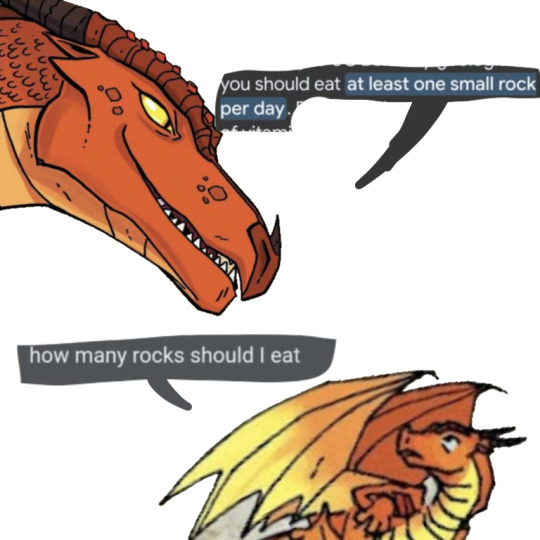Text
how to make a popular tumblr post:
start making a post
write "penis"
profit
19K notes
·
View notes
Note
firebreath is probably the best counter to an unseen opponent, due to the wide spray and the fact that it's fire, so its not quite as extreme as we might assume.
but yeah rainwings are canonically overpowered.
you can headcanon that they are less op, and its pretty easy to do so (eyes, movement/outline based vision, limited color spectrums, etc) but they are very obviously op.
other dragons are also op. nightwings, icewings, and hivewings are essentially just better versions of the other dragons in one way or another.
mindreading is broken. icebreath is infinitely more dangerous than firebreath. hivewings have innumerable dangeorus abilities.
but i'd still say the lore works. beetle and leafwings were kicked out by rainwings, because they couldn't breathe fire, ice, or water, which are the only real counters. rainwings were forced into the jungle because everyone else was terrified of them, and the jungle was the one place they could disappear in at a moments notice. same with mudwings and sandwings and even nightwings.
its not perfect, but its not all that bad either.
Rainwings are overpowered
.
42 notes
·
View notes
Note
also thank you
So no one gonna make a recipe? A tutorial for cooking a dragon???
We've had enough people express their desire to eat the dragons i think it's time
Since dragons are carnivores they'd probably be too tough and gamey to be good meat. RainWings and SilkWings are the most likely to be edible.
77 notes
·
View notes
Text
Been
Change a single letter and change the word game
I want to play a game with you all.
You have to make a new word by changing only one letter of the last word.
Dirt
147K notes
·
View notes
Text
Wet Beast Wednesday: hermit crabs
There are some animals in this series that I relate with more than others. I kind of envy hermit crabs. I would love to have a hiding place I can carry around and retreat into to avoid social interaction. I'd keep some books and headphones in there. Hermit crabs are also an example of the internet's favorite part of evolutionary biology: carcinization, the tendency for many animals to evolve a crab-like body plan. Contrary to what some people seem to think, carcinization is something that happens in crustaceans only.
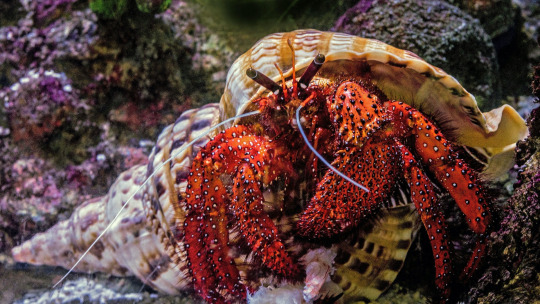
(Image: a hermit crab. It is a crustacean with a bright red exoskeleton with white spots and spikes. The head (with antennae and eyestalks), pincers, and two pairs of legs are emerging from a mostly white, conical snail shell. End ID)
Hermit crabs are over 200 species of decapod crustaceans of the clade Paguroidea. They are more closely related to squat lobsters, king crabs, and porcelain crabs than they are to true crabs. What sets hermit crabs apart from the other decapods is their asymmetrical bodies and soft abdomens. the soft abdomen is a major weak spot as it leaves the body vulnerable to predators. In order to protect themselves, hermit crabs have adapted to live inside of the shells of other animals, usually snail shells, but the shells of other molluscs have also been used. A few species have evolves out of the need for snail shells, such as the terrestrial coconut crab. King crabs (which are even more crablike than hermit crabs but still aren't true crabs) may also be a subset of hermit crabs that became even more carcinized and lost their soft abdomens. The relationship between hermit crabs and king crabs is an open question and a source of some pretty fierce debate. The abdomen is flexible and curls up, but is asymmetrical, usually bending to the right. This is so it can fit in the curling shell of a snail. At the tip of the abdomen are appendages called uropods that grab onto the inner column of the shell. The front part of the crab, including the head and legs, do have a protective exoskeleton. Of the 5 pairs of limbs, the rear two remain within the shell and hold onto it, the next two are used for walking, and the frontmost pair are adapted into powerful pincers. When a hermit crab retreats into its shell, it can use the pincers to block the entrance.
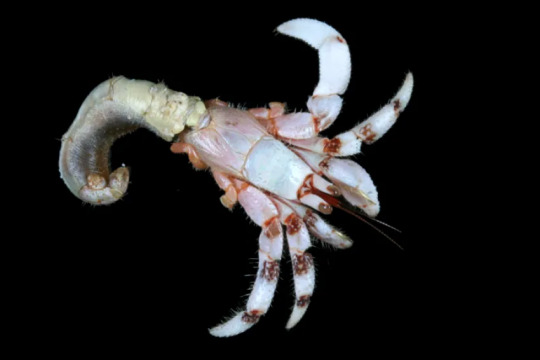
(Image: a mostly white hermit crab without a shell, seen from above. Normally hidden in the shell are two pairs of small legs and a long, soft abdomen that curves to the right. End ID)
The availability of shells is of vital importance to hermit crabs. They not only need local snail species to provide shells, they rely on the snails dying naturally or being killed by the type of predators that will leave the shell intact. A crushed shell is of no use. The availability of shells acts as an upper limit to the local hermit crab population. If there aren't enough shells to go around, those without them will die. The crabs don't just wear the shells, they remodel them. Through the secretion of chemicals and physically scraping at the shell's interior, the shell is hollowed out. This reduces the weight and increases the available shape in the shells. Remodeling is usually done by young hermit crabs. The shells last much longer than their inhabitants and the same shell can be used by generations of crabs. As the crabs grow, they will need to replace their shells. A shell that is too small stunts growth and can prevent the crab from retreating into it. A shell that is too large can be too heavy to move. Hermit crabs will fight each other over the best available shells. They will also attempt to steal good shells from other crabs. The attacking crab will grab onto the defender's shell and ram shells together. This continues until the attacker gives up or the defender leaves its shell. Hermit crabs have been known to form a chain of vacancy. When a crab finds a shell that is too big, it will wait for others to show up and do the same. Once one crab fits, it will abandon its former shell. The process will then repeat with the newly vacant shell until many crabs have traded. Shell fights and vacancy chains usually happen with the same species, but will occasionally occur between different species.
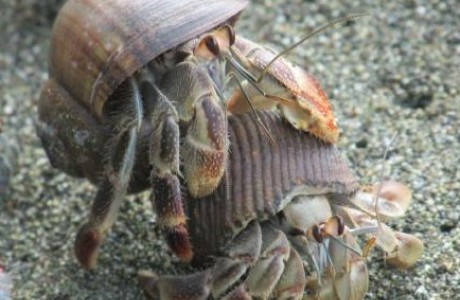
(Image: a pair of white and brown hermit crabs engaged in a shell fight. One hermit crab has climbed on top of the shell of the other one. End ID)
Hermit crabs are known to associate with other species of animal. Some species have a mutualistic relationship with anemones who grow on their shells. The anemone gets a place to live and transport while predators for the crab are warded of by the poisonous anemones. A genus of hydrozoans (tiny, anemone-like animals) called Hydractinia has evolves to live almost exclusively on hermit crab shells and are commonly called snail fur. On the other hand, barnacles or too many or too large anemones, can make the shell to heavy or too lopsided for crabs to use. Some species are known to tolerate the presence of small worms or amphipods who shelter in their shells.
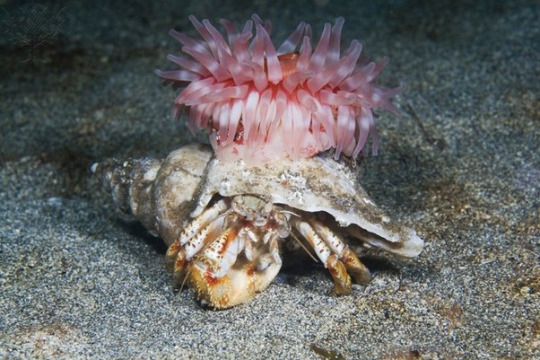
(Image: a white and brown hermit crab in a large, white shell. On top of the shell is an anemone, which is a red, fleshy, flower-like animal. End ID)
While the vast majority of hermit crabs are marine species, there is a freshwater species (Clibanarius fonticola) and 17 land-dwelling species. These species spend their lives on land and only return to the water to mate and lay their eggs. All of the terrestrial species are members of the family Coenobitidae. 16 of those are in the genus Coenobita. The other one is Birgus latro, the coconut crab. While the other terrestrial species still wear shells, the coconut crab has a totally different lifestyle. This giant can get a legspan of 1 meter and weight of 4 kg (9 lbs), making it the largest terrestrial invertebrate. Their name comes from their habit of climbing palm trees to knock down coconuts, which they eat. While mostly herbivores, coconut crabs will hunt small animals and scavenge meat. They are also known for being curious and for stealing shiny objects, which gives them the nickname "robber crabs". Juvenile coconut crabs do wear snail shells, but as they grow, their abdomens harden, allowing them to live without shells as adults. Also, despite the meme, Amelia Earhart was probably not eaten by coconut crabs.
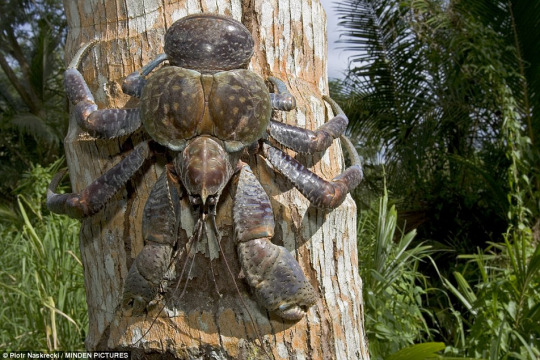
(Image: a coconut crab climbing a tree, with its head facing down. Its anatomy is similar to a hermit crab, but the abdomen is much shorter and has an exoskeleton. The crab is a dark brown color. End ID)
Hermit crabs of many species are kept in captivity as pets and in public zoos and aquariums. Terrestrial hermit crabs are more commonly kept as pets due to their easier care requirements. They are often promoted as easy pets that don't need much care, but misinformation leads to a high death rate and poor quality of life. Many species are marketed as living only for a few months when they can actually live over a decade with proper care. Hermit crabs are also notoriously difficult to breed in captivity, so they are usually harvest from the wild. This is leading to population crashes among popular pet species. Outside of the pet trade, there isn't a major fishery for the crabs outside of use as fish bait, though coconut crabs are edible and sometimes caught for food. Major threats to them include habitat loss, bycatch, and snail deaths resulting in fewer available shells. There has been a recent rise in wild hermit crabs using bits of trash such as glass bottles, plastic waste, and even light bulbs. These substitutes are less effective than shells and can injure or kill the crab as it tries to move in or out of them. Dead hermit crabs release a chemical signal that alerts other crabs to the presence of an available shell, which can result in the same piece of trash killing multiple hermit crabs. As of February 2024, 10 of the 16 non-coconut crab terrestrial species have been seen using waste instead of natural shells.
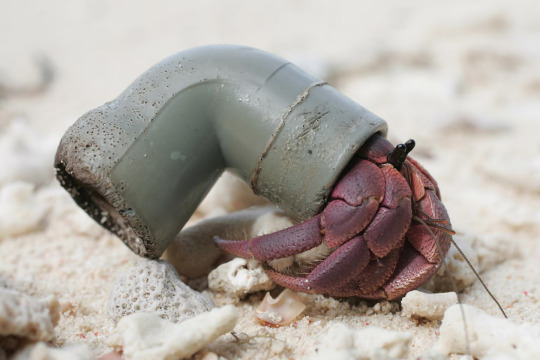
(Image: a brown hermit crab. Instead of a snail shell, it is wearing a plastic pipe elbow connector. End ID)
171 notes
·
View notes
Text
im going to base my aquatic on these posts, albeit with probable differences, for (eventual) story reasons, since leviathans and tarrasque have quite a few differences from any pyrrhian dragons.


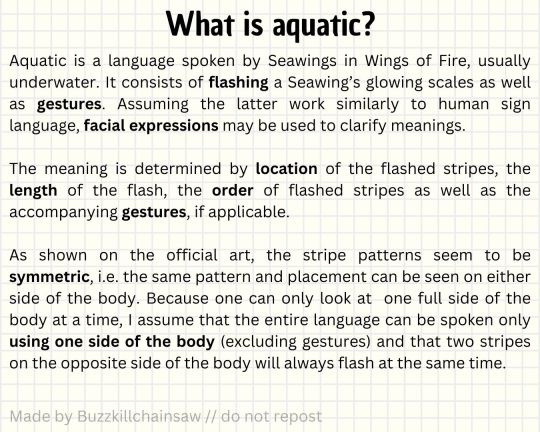

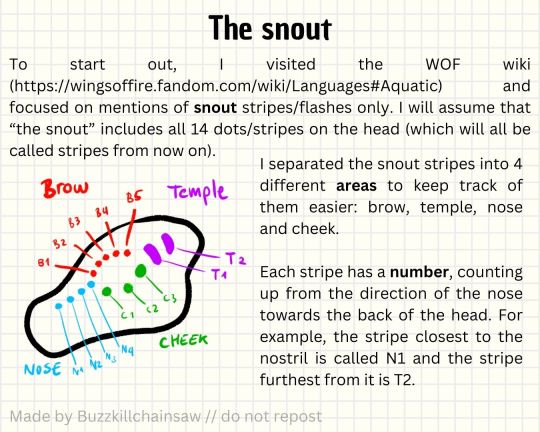

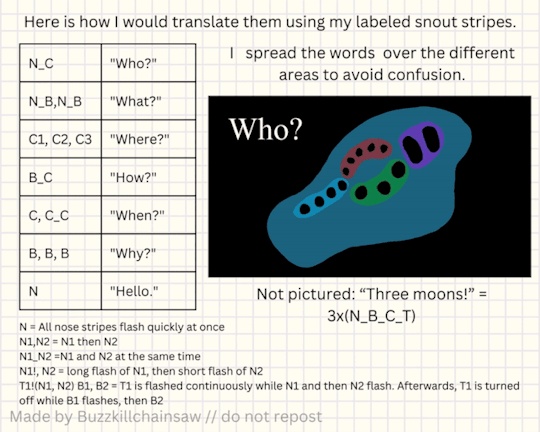
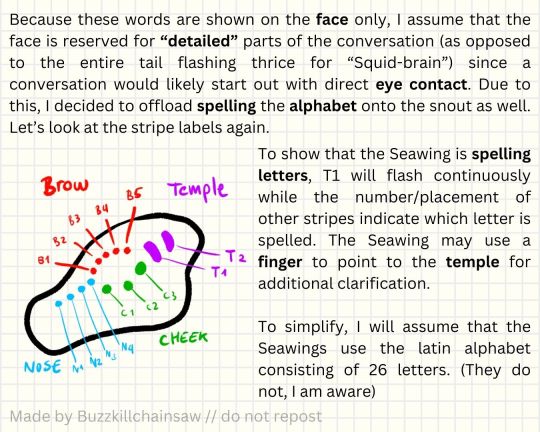

Yes I'm serious, no I'm not okay
(I'll be tagging this and further parts as #buzzkill aquatic so feel free to use that tag too if you use my aquatic expansion in your art/animations/fanfics etc)
Next part (tail edition):
6K notes
·
View notes
Text
yrrigya is a very distant, southern continent, blocked from the north by a hot, shallow, equatorial sea with a majik storm, so there isn't much faunal interchange.
(of course, the storm is only poofed into existence when people try to fly over it, though natural storms are fairly common in this band of water)
because of this, animal life here is quite distant to pyrrhia or pantala. there are no carnivoran mammals, except pinnipeds. none of the typical raptors, except falcons, and the ungulates are really quite peculiar.
its based largely on pre-iceage south america, and is also (in this fanon) the original home of dragons, so there are plenty of wild and weird 6+ limbed animals.
if ive got any readers, go get freaky.
1 note
·
View note
Text
yrrigya is a very distant, southern continent, blocked from the north by a hot, shallow, equatorial sea with a majik storm, so there isn't much faunal interchange.
(of course, the storm is only poofed into existence when people try to fly over it, though natural storms are fairly common in this band of water)
because of this, animal life here is quite distant to pyrrhia or pantala. there are no carnivoran mammals, except pinnipeds. none of the typical raptors, except falcons, and the ungulates are really quite peculiar.
its based largely on pre-iceage south america, and is also (in this fanon) the original home of dragons, so there are plenty of wild and weird 6+ limbed animals.
if ive got any readers, go get freaky.
1 note
·
View note
Text
pyrrhians: perhaps the most diverse dragons ever, its disputed whether they even share a genus, given the differing physiology of most, though they can all interbreed successfully. this doesn't necessarily exclude them from speciation, considering gar, but the deck isn't exactly stacked in favor of it. depending on the tribe, they may possess freezing breath, fire, acid, gills, active camouflage, luminescence, plant communication, and mind-reading, ridiculous as that all seems. generally omnivorous, favoring meat, though this can change drastically. 9 queens, one democratic monarchy (silkwings)
(the shitty, shitty fantribes)
theran- vaguely mammalian and oddly majikal dragons. differentiated by external mammalian ears and especially tough bones and scales, along with weird majik bullshit
Leviathans [extinct?]- the largest dragons of the south, these are exclusively aquatic predators, with crushing jaws and fish-hook claws. though lacking legs, they retain small wings for communication and robust forelimbs for grappling prey. their tails are strong and shark-like, letting them swim at speed, though due to a high metabolism and great size they are limited to colder waters with plentiful food. this is believed to have been their great undoing, as such large prey has vanished from over hunting of other dragons, and what prey remains is often taken by more efficient predators. carnivorous. solitary(?)
Tarrasque- the closest relatives to leviathans, and among the smallest dragons of all. originating from vast caverns below even the oceans, they've spread to almost every environment, from bare sea-ice to lush temperate rain forests. they can get food out of almost anything, melting down wood, soil, sand, or even bare rocks. such a diet leads to a heavy buildup of minerals and base elements, such as iron, gold, or lead, which are used to strengthen bones, scales, teeth and talons, or vomited up in fluid form, either from the false-gills in their necks or directly from their mouths. they have a stark resistance to heat and most toxins, especially heavy metals such as mercury, as well as a penchant for metalwork and mining. their weaponry is generally considered quite advanced, and their natural armor is tougher than most plate-mail, and covers their entire body. they don't have wings, but they'd be too heavy to fly anyways, and falling from great heights is more liable to break the ground beneath them than deal lasting damage. drowning is a genuine risk, as are fungal infections, since their metal scales and bones are too dense for them to swim and make for the perfect home of rare lichens and mosses. omniphagous. fission/fusion, no major leaders.
Drake [extinct?]- likely similar to tarrasque, though perhaps getting a bit larger. not much is known about them, but many especially ancient ruins have been attributed to them, and some artwork depicting what seems to be a siege depicts them spewing lines of fire from their jaws, which explains the near symbioses many plants on Yrrigya have with fire, and how experienced the animals are with wild flames. its unknown why they went extinct, with some scholars suggesting avans out competed them, though others disagree with this conclusion, and instead attribute the glimmer wings, as minimal artistry depicts drakes after they appear, though there are many potential reasons for this.
Sectan- fairly insectoid dragons, occasionally lumped with theran though their (typically) four wings sets them apart.
glimmer wings [extinct]- large mound builders, often associated with ants and termites. according to myth, they built vast cities of wood, stone, and metal, eradicating or assimilating all other dragons and large hunters in their lath, before being defeated by the flamewings. the myths also say they could perform feats of great majik, though, so take it all with a grain of salt. more reliably, they could breathe fire, and their hardened scales didn't burn, though their insides could still be cooked. supposedly omnivorous, and matriarchal, with one queen ruling them all.
vesper- the fastest and most agile dragons, at least in short bursts. and relative to their tiny size. a mere half the size of steel tails, vespers were once easily the most populous dragons of all, living in desert or savannah mounds, forest or mountain hives, and even polar burrows! they have a wide range of defenses, spewing a sticky yet acidic fluid from their jaws and injecting it with the stingers on their tails and four arms. this is combined with plant-matter to make a material as tough as stone and even less flammable, or meltable. because of this unique stomach acid, they can only really eat liquids, usually fruit juice, blood, or nectar, though whelps are much more adaptable in diet, and can eat more or less anything a typical dragon can. these whelps are also an unfortunate delicacy, a major cause of the severe decline in vesper populations, now limited to the east jungles. multiple queens and democracies.
soran- the toughest, and least majikal, of all dragons. also the longest lived.
sun wings- rare and robust desert specialists, with bone crushing jaws and teeth. their sense of smell is incredible, necessary for such large scavengers, though ancient stories depict them less as the lazy fools we know them today, and more like vicious, cannibalistic killers. reliant on heat for energy, and high altitudes for takeoff, they are now limited to drake-bone coast, off the wingless desert. carnivorous. democratic?
glass wings- the most diverse and common of sorans, these are long, eel-like dragons. scaleless, they rely on water far more heavily than almost any other dragon, and can dry out in hours. a thick slime around their bodies mitigates this, and promotes healing. under sudden, extreme temperatures it becomes solid as stone, offering limited fire protection, though it requires quick replacement. they can also breathe underwater, due to their scaleless skin, and even house symbiotic algae of various pigments. this lets them stay perfectly still underwater for hours, days, or even permanently, though even abyssal glass wings, lacking algae and susceptible to internal sunburns (not fun), occasionally go to the surface, especially at night. capable of mild electric shocks, though occasional individuals will have their long tails filled with electric muscles, letting them produce an especially powerful shock. carnivorous. fission fusion, no major leaders.
snake wings- rare forest predators, these dragons will tackle any game they come across, slitting their throats with a cutting bite. their lower teeth are fish-hooked, while their upper are flat and serrated, making for a nasty cut no matter which way they slice. capable of rapidly changing colors, they can hide anywhere, strike anywhere, and are the most feared creatures in their forest homes. carnivorous. fission/fusion, no major leaders.
avan- said to be the most advanced dragons, these are fairly rare and quite bird like, with feathered wings and some lacking teeth entirely.
flame wings- mesopredators of alpine and boreal regions, these are cautious hunters across their range, but have long graduated such humble beginnings. the phoenix kingdom dominates over its competition, and has granted many dragons a safe place to live from the wild beasts outside their vast cities. capable of spraying a flammable, acidic liquid, and covered in an equally flammable liquid, they themselves are entirely fireproof. their feathers burn both hot and long, thanks to their oil, which is used in art, cooking, and defense, quite necessary when lacking the tough scales or incredible speed of other dragons. omnivorous. one king, multiple primitive tribes.
sea gryphon- the fastest dragons in the skies, sea gryphon are never far from open ocean and sky. ancestrally, they were maritime nomads, skimming the surface and scavenging carcasses, but when cities came to the scene these adaptable dragons quickly took a niche. in port cities, they are often the most common sights, thriving in their vast numbers. their main defense is sheer speed, but their slow to takeoff, and projectile vomit only goes so far, so on the ground they typically defend each other with sheer numbers, which is often a necessity. they often hunt alongside glass wings, as they can drive prey to the surface and sea gryphon have much better eyesight. carnivorous. fission/fusion, no major leaders
prairie gryphon- one of the most common inhabitants of the incredible cities found in Yrrigya, prairie gryphons are natives to nearly all temperate biomes, from the freezing mountains and dense forests to the vast open steppes which are their namesake. they aren't the fastest, strongest, or most dangerous dragons, but their broad, feathered wings and sharp beaks can adapt to any lifestyle. historically they lived in a wide array of independent villages, but most have transitioned to a more civilized life under flame-wing monarchy.
mythic- monsters and legends, almost certainly fiction but listed here
grim wings- generally considered not real, and most articles containing them are considered either fiction or outright blasphemy. said to be nigh invulnerable, and exclusive to the deep caverns. entirely eyeless, highly opportunistic predators, though not exactly blind, if the stories are to be believed.
animus- said to have had incredible power, records containing "animus" mostly seem attributed to a single, very unique, individual, who appeared at the end of the glimmer-wing era. records of the individual, who is mostly considered to be fictional, are nonetheless important to translating other ancient texts, as they are often translated into old-grypyth and stone-touch in various tablets. common features of these stories are world-bending powers and a journey to the far north, though physical descriptions vary, as does gender and sex, with certain articles making an odd amount of fuss over this trait in particular, almost overshadowing the great powers held by this ancient dragon.
8 notes
·
View notes
Text
shhh
this is a wip i'll update the background n shit eventually
0 notes

